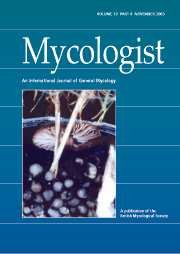Article contents
Teaching techniques for mycology: 20. Astaxanthin, a carotenoid of biotechnological importance from yeast and salmonid fish
Published online by Cambridge University Press: 03 December 2003
Abstract
Name of fungus
Phaffia rhodozyma W. M. Miller et al.
Introduction: Features of interest
Carotenoids are a group of over 600 molecules which can be found in most life forms and fulfil diverse functions, ranging from their original evolutionary role as photosynthetic or light-quenching pigments to antioxidants, precursors of vitamin A, or pigments involved in the visual attraction of animals such as flower pollinators or mating partners (Johnson & Schroeder, 1995). They are also thought to reduce the incidence of cancer and degenerative diseases in man, probably due at least partly to their antioxidant role in protecting sensitive biological molecules from highly reactive oxygen species or free radicals (Bendich & Olson, 1989; Nishino et al., 1999). Carotenoids are synthesized de novo by many bacteria, all photosynthetic algae and higher plants, as well as some fungi, but not by animals which must therefore satisfy any carotenoid requirement they have from their diet. Thus, for instance in marine ecosystems, planktonic algae are thought to be the primary producers of carotenoids which then pass through the food chain, eventually accumulating in crustaceans and fish feeding on them (Johnson & Schroeder, 1995). This is true especially of astaxanthin, a natural derivative of the most abundant carotenoid, ß-carotene, which gives many marine crustaceans as well as salmonid fish their typical orange-red colouration (Johnson & An, 1991). Considerable quantities of astaxanthin must be added to the feed of farmed salmon in order to obtain a healthy crop of fish as well as satisfying the eye of the consumer (Meyers, 1994). Astaxanthin may even contribute to the taste of cooked salmon (Josephson et al., 1991).
- Type
- Original Article
- Information
- Copyright
- © 2003 Cambridge University Press
- 9
- Cited by


